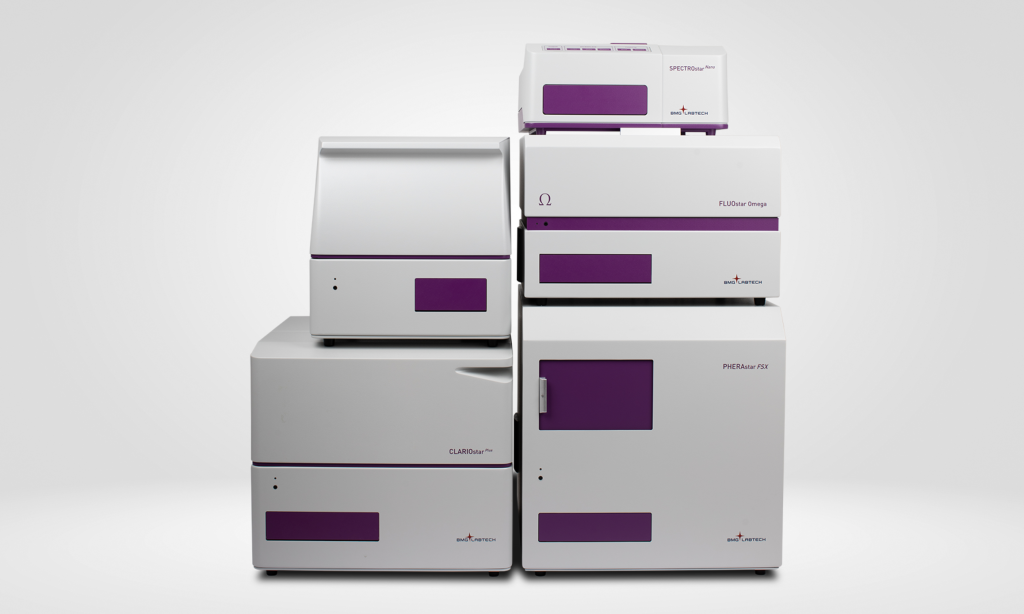An important part of any laboratory is the measurement equipment. The objective quantification of biological processes in multiple samples with low volumes is central to life science and pharmacological research – which is why the microplate reader is so popular within the scientific community.
What is a Microplate Reader?
Microplate readers enable the quantitative analysis of biological, chemical, and physical events in multi-well plates. The resulting data are then used by scientists to answer different biological or chemical questions. Microplate readers facilitate a variety of experiments to be performed and measured at low volumes and in multiple samples. Multi-well plates or simply microplates are an important part of this process, as they allow many samples to be analysed at the same time (the standard microplate can carry 96 different samples), which leads to fast and incredibly accurate results.
The instruments are used to conduct absorbance, fluorescence, and luminescence measurements. The measurements are performed as follows: a microplate with samples is inserted into a microplate reader. Upon luminous or biochemical stimulation, the samples produce a light signal that is then quantified by the plate reader. The throughput aspect of the measurements is conducive to wide commercial, public, or experimental use. Microplate readers are used for instance to quantify proteins, gene expression, and several metabolic processes.
Multi-mode microplate readers combine different detection modes and allow for flexibility and ease of use over a broad range of assays. The devices are used in life science, drug discovery and assay development. They are used for instance to measure gene expression, protein, and various metabolic pathways such as calcium flux and reactive oxygen species. As mentioned above, the three most common read modes of a microplate reader are absorbance, fluorescence, and luminescence, which will be introduced more closely below:
Absorbance
Absorbance microplate readers are very popular in laboratories and allow the measurement of the “optical density” of a sample. In biochemistry, absorbance measurements are considered an important tool for the quantitative determination of biomolecules. Absorbance microplate readers are used, among others, in the field of life science research, but also within drug discovery and screening. Within the reader, the samples are illuminated by a light source. Specific wavelengths are selected by an optical filter or spectrometer before or after they hit the sample. Absorbance detection is called an absolute measurement because it is quantified in optical densities, so to say, the ratio between the intensity of light hitting a sample and the intensity of light passing through the sample. The amount of transmitted light is usually related to the concentration of the corresponding molecule, and the result is called the optical density (OD) or absorbance of the sample.
Luminescence
Luminescence is the result of a chemical or biochemical reaction and, unlike absorbance, therefore does not require a light source for excitation. It is referred to as not an absolute measurement. The intensity of a light signal is therefore usually determined relative to other measurements or reference measurements. The system of a classical luminometer therefore consists of the following two main components: (1) a light-tight chamber for reading out the signal and (2) a PMT for detecting the signal. Luminescence plate readers are used for a variety of applications within different areas, including basic life science research, drug discovery and screening, synthetic biology, and food or water quality monitoring.
Fluorescence
Fluorescence intensity detection is one of the most popular detection technologies in microplate readers and is very widely used in life science research. Compared to absorbance detection, fluorescence intensity detection typically offers higher sensitivity and a wider dynamic range. Because many reagents can be fluorescently labeled, spectrofluorometers are used to detect numerous biological and chemical processes.
Sytems for the measurement of fluorescence intensity consist of two building blocks. First, a light source with a specific wavelength illuminates the sample in the excitation building block of the optical system. The exact wavelength is usually selected by an optical filter or a monochromator. The second component of the optical system collects the light emitted by the sample and a light detector quantifies its intensity. Fluorescence microplate readers support life science and drug discovery researchers who can thereby analyse multiple samples by using the fluorescent output as a proxy of the biological processes they want to investigate.
Whether you need a dedicated instrument or the flexibility of multiple reading options, a microplate reader can produce many and accurate results in a short amount of time. These masters in the lab can help move research forward, simplify handling,deliver objective data, and increase productivity.




